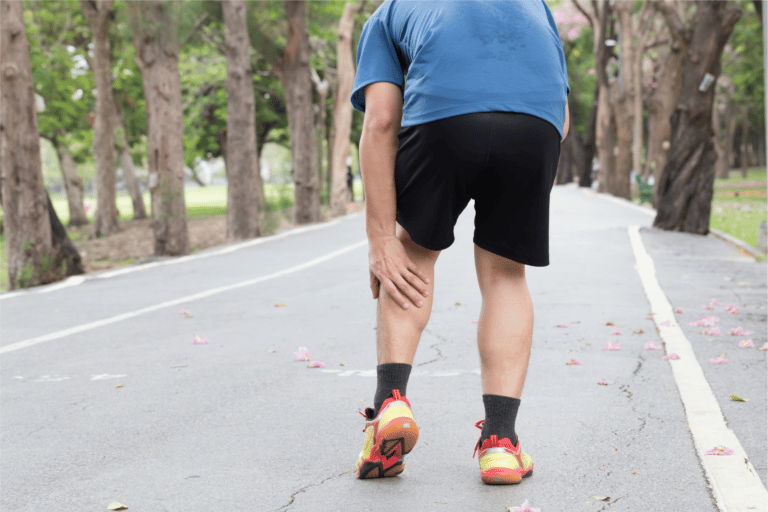The Impact of Trail Running on Body Composition: Insights on Fat Loss and Muscle Development
Trail running is more than just a way to enjoy nature—it’s an effective means to transform body composition. As a UESCA certified running coach, I’ve seen firsthand how the dynamic, uneven terrain provides a robust physical challenge that can lead to fat loss and muscle gain. It engages a wide array of muscles, contributing to improved muscle tone and overall fitness. Nutrition plays a crucial role in fueling and recovering from runs, with a balanced diet amplifying the benefits on body composition.
Ensuring a balance between health, nutrition, and physical activity is key for trail runners aiming to alter their body composition. Adequate protein intake supports muscle repair and growth, while a well-rounded diet helps manage weight.
Integrating trail running into your workout regimen offers a unique mix of cardiovascular and resistance exercise, which promotes fat loss while preserving or even increasing muscle mass. My experience in coaching runners has shown that this form of exercise, when done consistently, can significantly enhance body health and composition.
Fundamentals of Trail Running

Trail running combines the thrill of running with the challenge of diverse terrains, often set amidst stunning natural scenery. As a UESCA certified running coach, my focus is to guide runners to attain peak fitness through this exhilarating form of physical activity.
Essentials of Trail Running:
- Running Mechanics: Prioritize form; a stable core and alert posture help navigate uneven terrain.
- Cardiovascular Fitness: Trail running is an excellent aerobic exercise, enhancing heart health and reducing the risk of cardiovascular disease.
- Intensity: It naturally incorporates high-intensity interval training (HIIT) with variations in elevation and pace.
Training Tips:
- Start Gradually: Increase distance and difficulty over time to prevent overuse injuries.
- Consistent Routine: Aim for regularity in your workouts to increase stamina and strength.
- Dynamic Warm-Ups: Engage in exercises that boost range of motion and prepare your muscles.
Energy Expenditure:
Trail running is demanding and burns more calories than running on flat surfaces due to its varying inclines and need for greater stabilization.
Gear Selection:
- Use trail-specific running shoes for grip and protection.
- Dress in layers and moisture-wicking fabrics for diverse weather conditions.
By incorporating these elements, trail running not only improves physical fitness but also contributes to muscle strength and fat loss, all while enjoying the pleasures of outdoor exercise.
Influence of Running on Fat and Muscle
Trail running significantly impacts body composition by affecting fat loss and muscle gain. I’ll walk you through the specific effects on body fat, muscle adaptations, and the metabolic changes associated with this vigorous outdoor activity.
Physiological Effects on Body Fat
When I guide runners, I stress that regular running primarily taps into energy stores, leading to fat loss.
The balance between caloric intake and energy expenditure is key; trail running burns calories, creating an energy deficit which the body compensates for by breaking down fat stores. This process results in a reduction of fat mass and visceral adipose tissue—critical for improving health and performance.
- Fat Loss:
- Energy Expenditure: High compared to rest
- Fat Mass Reduction: Significant with consistent training
- Visceral Adipose Tissue: Reduced, contributing to overall health
Muscle Adaptations and Growth
As a UESCA certified running coach, I inform my clients that the running-induced stress on muscles leads to adaptations. Trail running, with its varying terrain, promotes muscle strength and endurance, particularly in the lower body.
Over time, the body responds to these demands through muscle growth and an increase in fat-free mass. It is important to complement running with adequate protein intake to support this muscle development.
- Muscle Gain:
- Strength Endurance: Increases with regular trail running
- Fat-Free Mass: Gains are expected for consistent runners
- Protein Intake: Essential for muscle repair and growth
Trail Running and Metabolic Changes
Delving into metabolic changes, I explain to runners that trail running enhances the metabolism, including an increase in resting metabolic rate. This means the body burns more calories at rest, further assisting with fat loss.
Besides, muscle tissues consume more energy compared to fat, meaning that as muscle mass increases through trail running, the body becomes more efficient at fat burning.
- Metabolic Efficiency:
- Resting Metabolic Rate: Elevated post-training
- Energy Consumption: Higher in muscle tissue vs. fat
Through consistent trail running, individuals will likely see a decrease in body fat and an increase in muscle mass, leading to a more favorable body composition and metabolic health.
Diet and Nutrition for Trail Runners

As a UESCA certified running coach, I stress the importance of a balanced diet for trail runners. Your dietary intake needs to reflect the high demands of the sport.
Carbohydrates: The primary energy source. Aim for complex carbs for sustained energy. A guideline is to consume 50-90 grams of carbohydrates per hour during runs over 60 minutes.
Proteins: Vital for muscle repair and recovery. Include a source of protein in each meal. About 15-20% of your total caloric intake should come from protein.
- Healthy Fats: Provide sustained energy. Nuts, seeds, and avocados are great sources.
- Water and Hydration: Carry water/electrolytes on long runs. Drink before feeling thirsty to prevent dehydration.
Nutritional Breakdown for Meals:
| Meal Time | Carbohydrates | Protein | Healthy Fats |
|---|---|---|---|
| Breakfast | 50% | 25% | 25% |
| Lunch | 50% | 30% | 20% |
| Dinner | 50% | 25% | 25% |
Consider your nutritional needs change as you transition through different training phases. Ensure your diet is adjusted accordingly. Remember, individual needs vary, so listen to your body’s signals.
Optimizing Training for Body Composition

To improve body composition through trail running, focusing on a holistic training approach that includes balanced volume and intensity, strategic periodization, and resistance training is essential. Tailoring these elements to individual goals and capabilities will optimize fat loss and muscle gain.
Balancing Volume and Intensity
I advise my runners to find a balance between running volume—the total distance or time spent running—and the intensity of their workouts. High intensity interval training (HIIT) can be effective for fat loss and improving cardiovascular health, but it should be carefully incorporated to avoid overtraining.
- Volume: Moderate to low (15-30 miles per week)
- Intensity: High (1-2 sessions per week)
- Low-Intensity Runs: Utilize for active recovery and endurance building
Periodization and Recovery
Periodization is structuring training into phases with varying focus and loads. I recommend incorporating periodization in your running regimen to maximize gains and minimize the risk of injury.
Base Phase:
- Increase mileage at a low intensity
- Focus on building endurance
Build Phase:
- Incorporate higher intensity workouts
- Begin introducing resistance training
Peak Phase:
- Highest intensity and volume
- Prepare for races or specific goals
Recovery Phase:
- Decrease load
- Allow for muscle recovery
Resistance Training Integration
For enhancing muscle strength and countering muscle loss, I integrate resistance training into my runners’ routines. It complements their running schedule by strengthening muscles that are less utilized on the run and promotes overall muscle balance and injury prevention.
- Strength Training Sessions: 2-3 per week
- Exercises Include:
- Squats
- Deadlifts
- Lunges
- Upper body work (push-ups, pull-ups)
Through strategic training intervention, focusing on these elements can effectively shift body composition by reducing fat mass and increasing muscle mass. Remember, consistency and progression are key to seeing changes in body composition.
Scientific Insights and Practical Applications of Trail Running on Body Composition

I’ve distilled key scientific findings and combined them with practical strategies that trail runners can employ to enhance body composition, specifically focusing on fat loss and muscle gain.
Controlled Trials and Systematic Reviews
Controlled Trials:
Controlled trials on trail running and body composition have shown that consistent participation can lead to fat loss and muscle preservation or gain. Evidence points towards the influence of high-intensity, uneven terrain, and prolonged duration of trail running in instigating these body composition changes.
- Fat loss: Several controlled trials suggest that regular trail running contributes to a decrease in body fat mass.
- Muscle gain: Trails often require uphill running and uneven surfaces that engage more muscle groups; this has been associated with muscle gain in controlled trial observations.
Systematic Reviews:
Systematic reviews, which aggregate findings from multiple trials, further corroborate that trail running, by nature of its variability and intensity, is beneficial in improving body composition.
- Health Benefits: Improvements not only in weight and fat loss but also in overall metabolic and cardiometabolic health are reported.
- Weight Maintenance: For those concerned with weight maintenance, evidence from systematic reviews suggests a favorable effect of trail running in maintaining a healthy weight.
Real-world Interventions
Real-world interventions for trail runners come down to incorporating a regime that balances exercise intensity and recovery:
- Exercise: Integrating varied terrain runs, with emphasis on enduring climbs and descents, is crucial.
- Health Benefits: Beyond body composition, trail running elevates overall health, including cardiometabolic markers.
- Weight Management: As a running coach, I encourage incorporating trail running as part of a balanced exercise routine for practical weight loss or weight maintenance strategies.
Intervention Strategies:
- Start Gradually: To avoid injury and ensure consistent training, start with shorter distances and gradually increase.
- Mix Intensity: Include both long, slow runs and shorter, higher intensity sessions to optimize fat loss and muscle gain.
- Nutritional Support: Pair your training with a balanced diet to fuel workouts and aid in recovery.
By considering the scientific insights from controlled trials and systematic reviews, and applying these real-world interventions, trail runners can effectively target improvements in body composition while also reaping broader health benefits.






